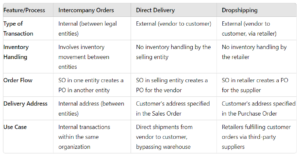Streamlining Supply Chain Operations: Understanding Intercompany Orders, Direct Delivery, and Drop shipping in Dynamics 365
In today’s fast-paced business landscape, companies must continuously optimize their supply chains to keep up with changing customer demands. Dynamics 365 Finance & Operations (D365 F&O) provides robust tools to manage various order fulfillment methods, such as Intercompany Orders, Direct Delivery, and Drop shipping. Each approach is designed to serve specific needs and offers its own set of advantages. Below is a detailed comparison to help you understand how each method works, how they differ, and when to implement them.
1. Intercompany Orders
Definition: Intercompany Orders refer to transactions between two or more legal entities within the same organization, such as different subsidiaries or branches.
Key Characteristics:
- Internal Transactions: Used for internal transactions between legal entities within the same corporate structure.
- Linked Orders: An intercompany sales order in the buying entity automatically generates a corresponding intercompany purchase order in the selling entity.
- Inventory Movement: Typically involves the transfer of inventory between entities.
- Financial Reporting: Transactions are reflected in the financial ledgers of both entities.
Use Case: Ideal for when one legal entity within an organization needs to purchase goods from another, such as a subsidiary buying from a parent company.
Example: A manufacturing subsidiary in the UK purchases raw materials from its parent company in the US. An intercompany sales order is created in the UK, triggering a corresponding purchase order in the US.
2. Direct Delivery
Definition: Direct Delivery, also known as drop-shipping, is a process where goods are shipped directly from a vendor to the customer, bypassing the selling entity’s warehouse.
Key Characteristics:
- Vendor to Customer: The vendor ships products directly to the customer.
- Sales Order Originated: Starts with a sales order in the selling entity, which automatically generates a linked purchase order for the vendor.
- No Warehouse Handling: The selling entity does not receive or handle the goods, reducing lead times.
Use Case: Best for scenarios where immediate shipment from the vendor to the customer is required, such as special orders where warehousing is unnecessary.
Example: A company receives an order for a custom-built machine. The order is forwarded to the manufacturer (vendor), who ships the machine directly to the customer, bypassing the company’s warehouse.
3. Dropshipping
Definition: Dropshipping is a fulfillment method where goods are shipped directly from a third-party supplier to the customer, with the retailer acting as an intermediary.
Key Characteristics:
- Retailer to Vendor: The retailer forwards customer orders to a supplier who handles shipping directly to the customer.
- Supplier Manages Inventory: The supplier manages inventory and logistics, while the retailer focuses on sales.
- Price Differences: The retailer earns a profit based on the difference between the sale price and the supplier’s price.
Use Case: Common in e-commerce, where the retailer does not hold inventory but relies on suppliers to fulfill orders directly to customers.
Example: An online store lists products from various suppliers. When a customer places an order, the retailer forwards it to the supplier, who ships the product directly to the customer.
Summary of Differences
Benefits and Strategic Use
Intercompany Orders:
- Operational Efficiency: Automates internal trading processes between different legal entities, reducing manual errors.
- Financial Accuracy: Ensures balanced financial records across entities, aiding in compliance and reporting.
Direct Delivery:
- Reduced Lead Times: Bypasses warehousing, speeding up the delivery process.
- Cost Efficiency: Lowers inventory costs by eliminating the need for intermediate storage.
- Customer Satisfaction: Enhances delivery speed, improving customer experience.
Dropshipping:
- Low-Risk Business Model: Ideal for businesses looking to minimize inventory costs.
- Scalability: Allows retailers to expand product offerings without the need to invest in inventory.
- Flexibility: Enables retailers to quickly adapt to market trends and customer demands.
Conclusion
Each of these fulfillment methods in Dynamics 365 Finance & Operations serves a distinct purpose and offers unique advantages depending on your business model and operational needs. By leveraging the appropriate method—whether Intercompany Orders for internal trading, Direct Delivery for streamlined shipments, or Dropshipping for low-risk retail—you can optimize your supply chain, reduce costs, and enhance customer satisfaction. Understanding these processes and implementing them effectively can significantly improve your organization’s efficiency and profitability.

Tags In
Related Posts
Leave a Reply Cancel reply
You must be logged in to post a comment.
Categories
- Advanced Warehouse Management (4)
- Expense Management Process (1)
- Free In Person Trainings (2)
- Free Microsoft Training Videos on YouTube (19)
- Intensive Microsoft Bootcamps: Learn Fast, Learn Smart (7)
- Inventory Management (1)
- Life Cycle Services (1)
- Microsoft D365 Security (1)
- Microsoft Dynamics 365 Finance and Operations (18)
- Microsoft Dynamics Finance (28)
- Microsoft Dynamics HR & Payroll (4)
- Microsoft Dynamics Retail & Commerce (2)
- Microsoft Dynamics Supply Chain Management (23)
- Uncategorized (2)






